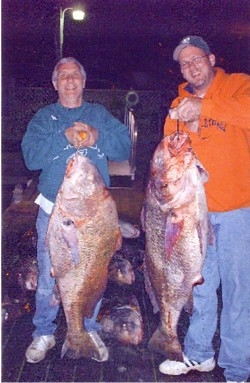| Bangin' Delaware Bay's Drum By Capt. George Smith, Heavy Hitter Sportfishing, Cape May |
|||
|
Black drum from pups to 80-pounders start moving into Delaware Bay from mid to late April and stick around until mid June or sometimes later. Early in the season the drumfish are caught both during daytime and in the evening. As the month of May progresses the bite seems to switch to an afternoon and evening one. These fish can be caught at a number of spots from the Jersey side of the bay to the Delaware side. On the Jersey side the spots include the Horseshoe, Banana Peel and Tussy’s Slough to name a few. On the Delaware side Slaughter Beach is a well-known area. Let’s move on to picking your destination. Weather is a factor and should be considered for safety before leaving for your trip. The weather on Delaware Bay can become nasty at times, with rough seas, strong winds and fog. This can make for a long ride home on a small vessel as well as on a large boat. When fishing at night, on some trips I’ll choose spots so I don’t have to travel so far if the weather might be rough. You might have some days when the bay is flat calm and others when the winds are blowing 20 to 30 m.p.h., kicking up seas. Remember that you should never take a break from safety. Upon reaching your spot, slow down and start watching your fish finder to see if any fish are being marked. If the area looks good for fish, try to anchor up-tide and drift back, and try not to spook the fish. But if no fish are marked, or if few are seen, don’t be afraid to stop and try it, because these fish are always on the move. On some trips I might not mark any fish or very few. But I’ll stop to fish anyway, knowing I caught fish in that area before. Upon fishing, you might end up hearing them drumming and wind up with a good catch. Also, if there is a big fleet of boats, don’t be afraid to go off by yourself, because you might find it rewarding. But if you are fishing in a fleet, use common sense when anchoring. Try not to anchor close to others, and give yourself plenty of room to fish. This will prevent shouting matches with other boaters, and you won’t wind up swinging into other vessels when the tide changes. As for tackle, a big, heavy outfit isn’t needed for these fish. I have Ugly Stick Tiger rods with Shimano TR 200 reels, spooled with 30-pound Yozuri line. For a rig, just keep it simple. Use 3 to 4 feet of 50-pound leader, a 9/0 Gamakatsu hook and a fish-finder slider rig to attach the weight to. This is a medium outfit with plenty of back bone to handle an 80-pound drum. |
||
Don’t hesitate to change your bait after 15 or 20 minutes, because the clam will wash out. You want to keep your bait as fresh as possible. The action might start instantly, or it might take an hour or so, depending on the tide. The drum normally seem to bite so long as the tide is moving, but I’ve caught them during slack tides. When these fish are hungry, they want to eat. Remember that although these fish are big, they bite very softly. So if you feel a slight tap on your line, or if your line just gets tight, don’t be afraid to set the hook. Be aware that these fish are excellent bait stealers. After the hook up, we net a small fish and gaff a larger one. When gaffing a fish, you should stick it in the throat area, because the gaff won’t go through the scales of the drum elsewhere. The gaff will bounce off, maybe causing you to lose a big one. When we land a small drum, we try to release it if the customer doesn’t mind. Most customers are usually okay with it, because they’re trying for a big one. When the fishing is done and we get back to the dock, the charter takes its pictures, and the mate cleans the fish to complete the trip for them. These drum take some time to clean. If you’re not sure how to clean them, some tackle stores and marinas have a fish cleaning service and will do a good job. Remember this is a good-eating fish, so please don’t waste it. So if you’re now thinking of trying to catch a big, trophy drumfish, now is the time to go. If you don’t have your own boat, you might want to consider booking a charter. I hope your drum trip is both safe and successful this season. |
|||




